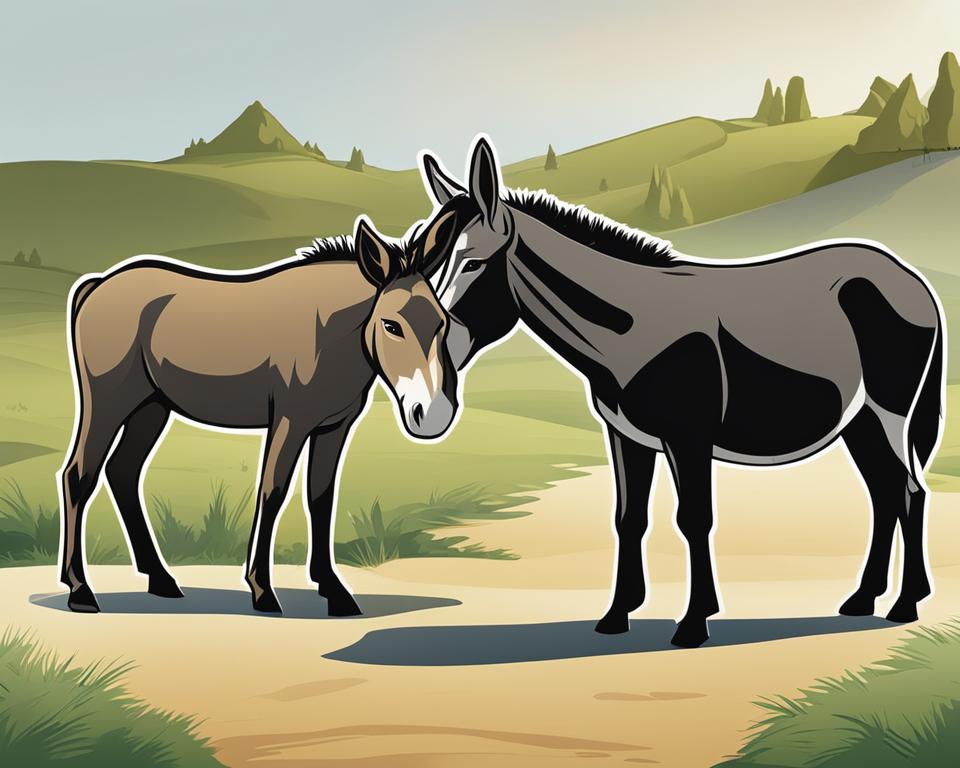Donkeys and mules may look similar with their long ears, broad heads, thin limbs, and short manes. However, there are several differences between them. Mules are the offspring of a male donkey and a female horse, and they tend to take after their mothers in terms of body shape, size, and coat. Mules are often mistaken for horses rather than donkeys, and they are typically larger than donkeys, standing at about 60 inches at the withers compared to 45 inches for donkeys. Mules also have a slight curve in their backs, similar to horses, while donkeys have flat backs. Donkeys have a primitive marking known as a dorsal line, which mules do not have. Donkeys’ ears are dark at the tips and edges, while mules’ ears resemble those of horses.

Key Takeaways:
- Donkeys and mules have physical similarities but differ in body shape, size, and coat.
- Mules are often mistaken for horses due to their larger size and slight curve in their backs.
- Donkeys have a primitive dorsal line marking, while mules do not.
- Donkeys’ ears are dark, while mules’ ears resemble those of horses.
- Understanding these differences is essential in identifying and appreciating these unique equids.
Key Characteristics of Donkeys
Donkeys, also known as Equus asinus, have several key characteristics that distinguish them from other equids. These unique traits contribute to their distinct appearance and behavior.
“Donkeys are known for their long ears, flat backs, and single toe on each foot,” says Dr. Jane Thompson, a renowned equine expert. “Their ears are longer and thicker compared to other equids, and they use them to communicate and regulate body temperature.”
In addition to their long ears, donkeys have shorter, thicker heads compared to horses and mules. Their backs are flatter and have one fewer vertebrae, resulting in a distinct body shape. Donkeys also have softer coats, usually gray in color, and a primitive marking known as a dorsal line that runs down their backs and across their shoulders.
Types of Donkeys
There are different types of donkeys found around the world, each with its own unique characteristics. The African wild ass and the Asiatic wild ass are closely related to domestic donkeys and share similar physical traits. These wild donkey species have adapted to survive in harsh environments, such as desert regions, and have a stronger build compared to domestic donkeys.
Overall, donkeys have a distinctive appearance and exhibit behaviors that separate them from other equine species. From their long ears to their flat backs and unique coat markings, donkeys are truly fascinating creatures.
Key Characteristics of Mules
Mules, as mentioned earlier, are hybrids bred from male donkeys and female horses. They are classified as Equus mulus and belong to the same family and genus as donkeys and horses. While mules share some physical characteristics with donkeys, they also display key differences that make them distinct.
One of the distinguishing features of mules is their size. Standing at about 60 inches at the withers, mules are typically larger than donkeys, who average around 45 inches in height. This increase in size is due to the influence of their horse mothers. Mules also have a slight curve in their backs, similar to horses, whereas donkeys have flat backs. Additionally, mules have thin limbs and narrow hooves, similar to donkeys, but their coats more closely resemble those of horses, varying in colors and patterns.
“Mules, as hybrids of donkeys and horses, exhibit a combination of traits from both parent species. Their larger size, curved back, and horse-like coat set them apart from purebred donkeys.”
Visual Comparison: Donkey vs Mule
| Characteristics | Donkey | Mule |
|---|---|---|
| Height at Withers | Approximately 45 inches | Approximately 60 inches |
| Back Shape | Flat | Slightly curved |
| Coat | Softer, usually gray | Similar to horses, various colors and patterns |
As the table and accompanying details illustrate, mules possess specific physical characteristics that differentiate them from donkeys. These attributes include their larger height, curved back, and horse-like coat. Understanding these distinctions is crucial in correctly identifying mules and appreciating their unique qualities.
Next, we will explore another important aspect that sets donkeys and mules apart: their reproductive abilities.
Differences in Reproduction
One of the key differences between donkeys and mules is their reproductive ability. Donkeys can reproduce normally, while mules are sterile. This distinction is due to the differing number of chromosomes inherited from their parents. Donkeys have 62 chromosomes, while horses have 64 chromosomes. Mules, as hybrids of a male donkey and a female horse, inherit an odd number of chromosomes, specifically 63. This odd number prevents mules from producing the haploid cells necessary for reproduction.
“Donkeys can reproduce normally, while mules are sterile.”
While it is extremely rare, there have been a few recorded cases of mules successfully reproducing, but these occurrences are outliers and not the norm. The sterility of mules is what makes them a unique hybrid, unable to continue their lineage through traditional means. This also contributes to their relatively low population compared to donkeys and horses.
To summarize, while donkeys have the ability to reproduce and continue their species, mules are sterile due to their hybrid nature. Donkeys have 62 chromosomes, horses have 64 chromosomes, and mules inherit an odd number of chromosomes at 63. This difference in reproductive ability is a notable distinction between donkeys and mules.
Table: Comparison of Reproductive Ability
| Species | Reproductive Ability |
|---|---|
| Donkeys | Capable of reproduction |
| Mules | Sterile |
Physical Differences
When it comes to physical differences, donkeys and mules have several features that set them apart. Donkeys have shorter, thicker heads compared to mules, and their ears are longer and thicker as well. On the other hand, mules have larger ears that resemble those of horses. A quick glance at their heads and ears can be a helpful way to distinguish between the two.
Another noticeable difference is in their coats. Donkeys typically have softer coats, often gray in color, while mules have coarser coats that are more similar to those of horses. These differences in coat texture and color can be quite distinct and easily spotted.
Donkeys have shorter, thicker heads and longer, thicker ears compared to mules. Mules, on the other hand, have larger ears and coarser coats similar to horses.
One unique feature of donkeys is the presence of a dorsal line, a primitive marking that runs down their backs and across their shoulders. This dorsal line is absent in mules. If you come across an equid with this distinctive marking, you can be confident that it is a donkey.
Overall, by paying attention to their head shape, ear size, coat texture, and the presence or absence of a dorsal line, you can easily identify whether you’re looking at a donkey or a mule.
Uses and Populations
Donkeys and mules have different uses and populations around the world. Donkeys, known for their hardiness and endurance, are commonly used as working animals in various industries such as agriculture, transportation, and tourism. They are especially valued for their ability to navigate rough terrains and carry heavy loads. Donkeys can be found in different countries, including the United States, Mexico, and parts of Africa and Asia.
Mules, on the other hand, are highly sought after for their strength and stamina. They are often used in agriculture and transportation, where their ability to pull heavy loads over long distances comes in handy. Mules have been used in farming, logging, and even military operations due to their reliability and durability. Countries such as China, Mexico, and Brazil have significant populations of mules, reflecting their usefulness in various industries.
Both donkeys and mules also exist in domestic and wild populations. Domestic populations refer to those that are bred and raised in controlled environments such as farms and ranches. These animals are often trained and used for specific purposes. Wild populations, on the other hand, live in their natural habitats and have minimal human intervention. These populations are important for the preservation of genetic diversity and the overall health of the species.
Donkey and Mule Populations by Country:
| Country | Donkey Population | Mule Population |
|---|---|---|
| United States | 1,500,000 | 150,000 |
| Mexico | 2,000,000 | 300,000 |
| China | 5,000,000 | 1,000,000 |
| Brazil | 1,200,000 | 200,000 |
Table: Donkey and mule populations in selected countries (2021).
Conclusion
In conclusion, understanding the difference between donkeys and mules is essential to accurately identify and appreciate these unique equids.
Donkeys, with their distinct features such as long ears, flat backs, and primitive dorsal line marking, are a distinct species. On the other hand, mules are hybrids bred from the combination of donkeys and horses. They exhibit larger size, a slight curve in their backs, and coats similar to horses.
Another key difference lies in their reproductive abilities. Donkeys are capable of reproduction, while mules are sterile. This is due to the odd number of chromosomes inherited by mules from their parents, which prevents them from producing the necessary cells for reproduction.
By understanding these differences, such as physical characteristics and reproductive abilities, we can appreciate the unique traits and roles of donkeys and mules in various industries and populations around the world.
FAQ
What are the key differences between donkeys and mules?
Donkeys and mules differ in their parentage, size, body shape, coat, and reproductive abilities.
How can I distinguish a donkey from a mule?
Donkeys have shorter, thicker heads and longer, thicker ears, while mules have larger ears resembling those of horses.
Can mules reproduce?
No, mules are sterile due to their odd number of chromosomes inherited from their parents.
What is the difference in the physical characteristics of donkeys and mules?
Donkeys have flat backs, softer gray coats, and a dorsal line marking, while mules have a slight curve in their backs, coarser horse-like coats, and lack the dorsal line marking.
What are the main uses and populations of donkeys and mules?
Donkeys are commonly used in agriculture, transportation, and tourism in countries like the United States, Mexico, and parts of Africa and Asia. Mules are popular for their strength and endurance and are found in countries such as China, Mexico, and Brazil.

![Ray Dalio Quotes [Principles, Life, Investment]](https://tagvault.org/wp-content/uploads/2023/04/Screen-Shot-2023-04-19-at-7.57.49-PM.png)